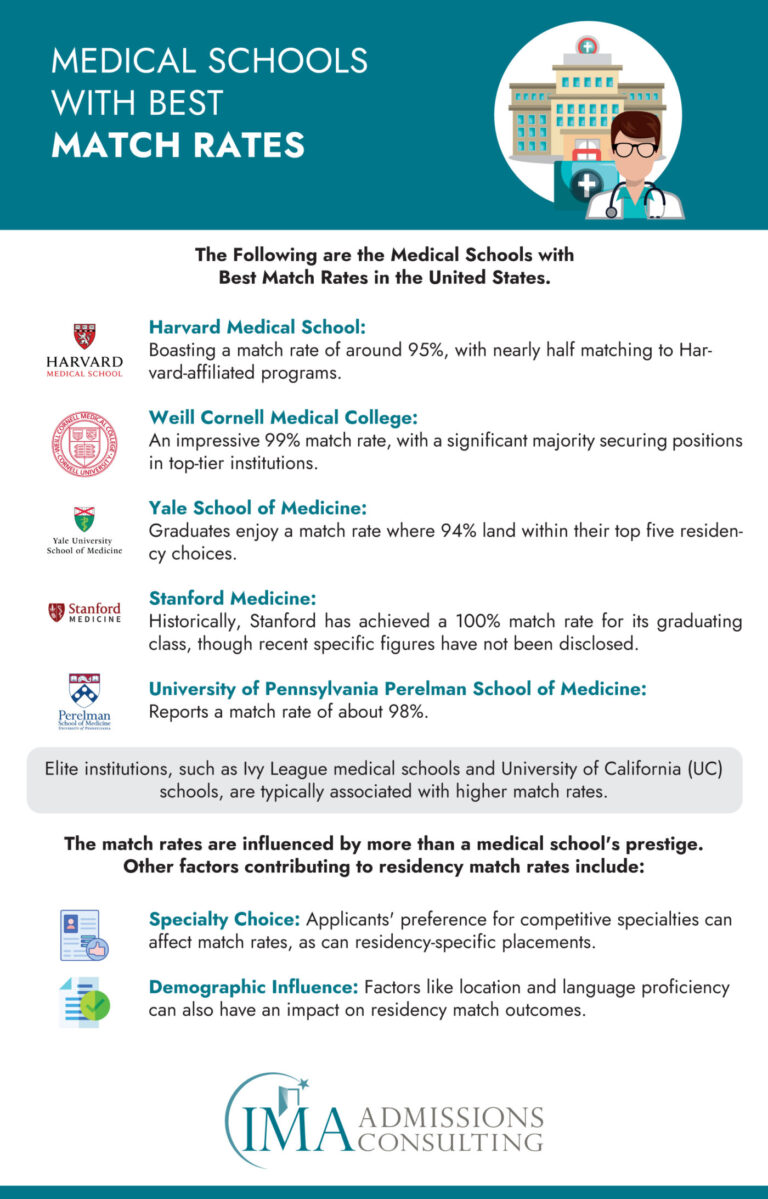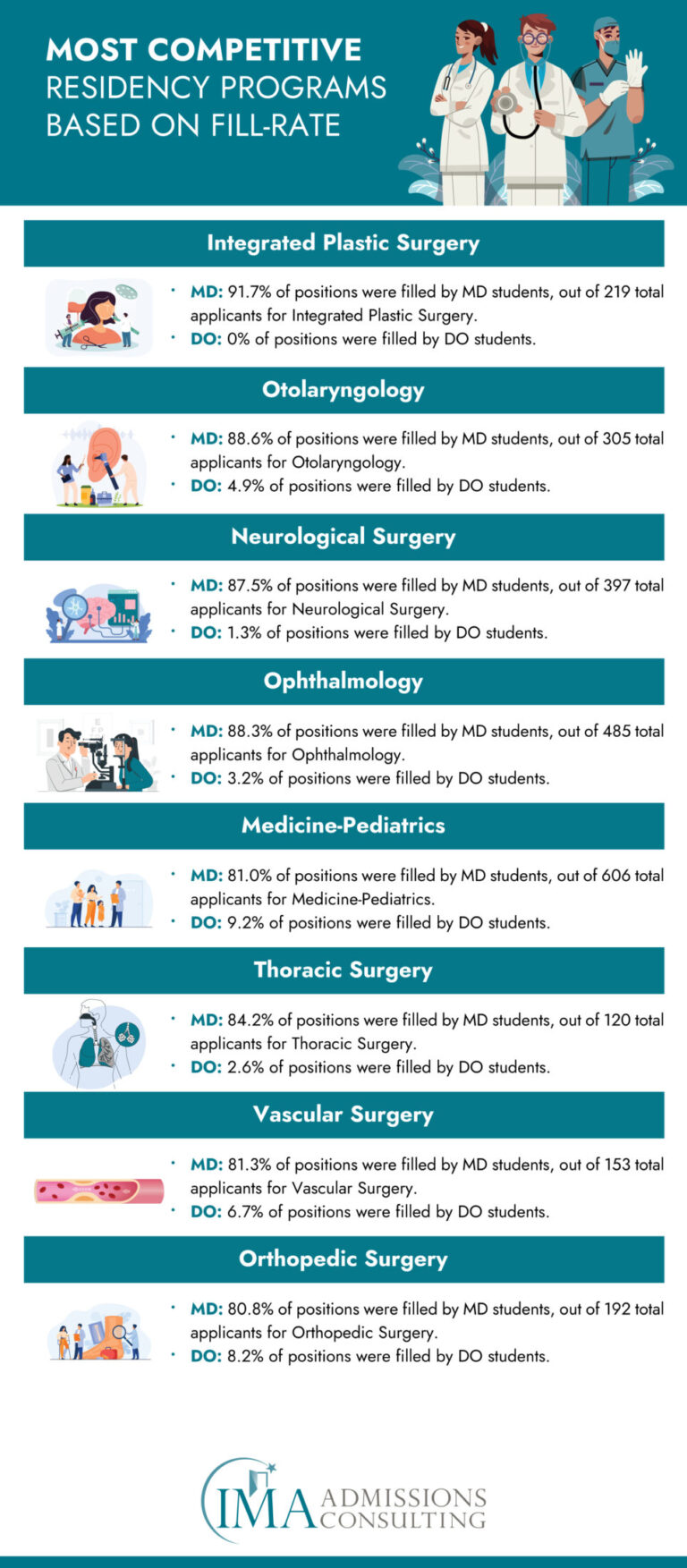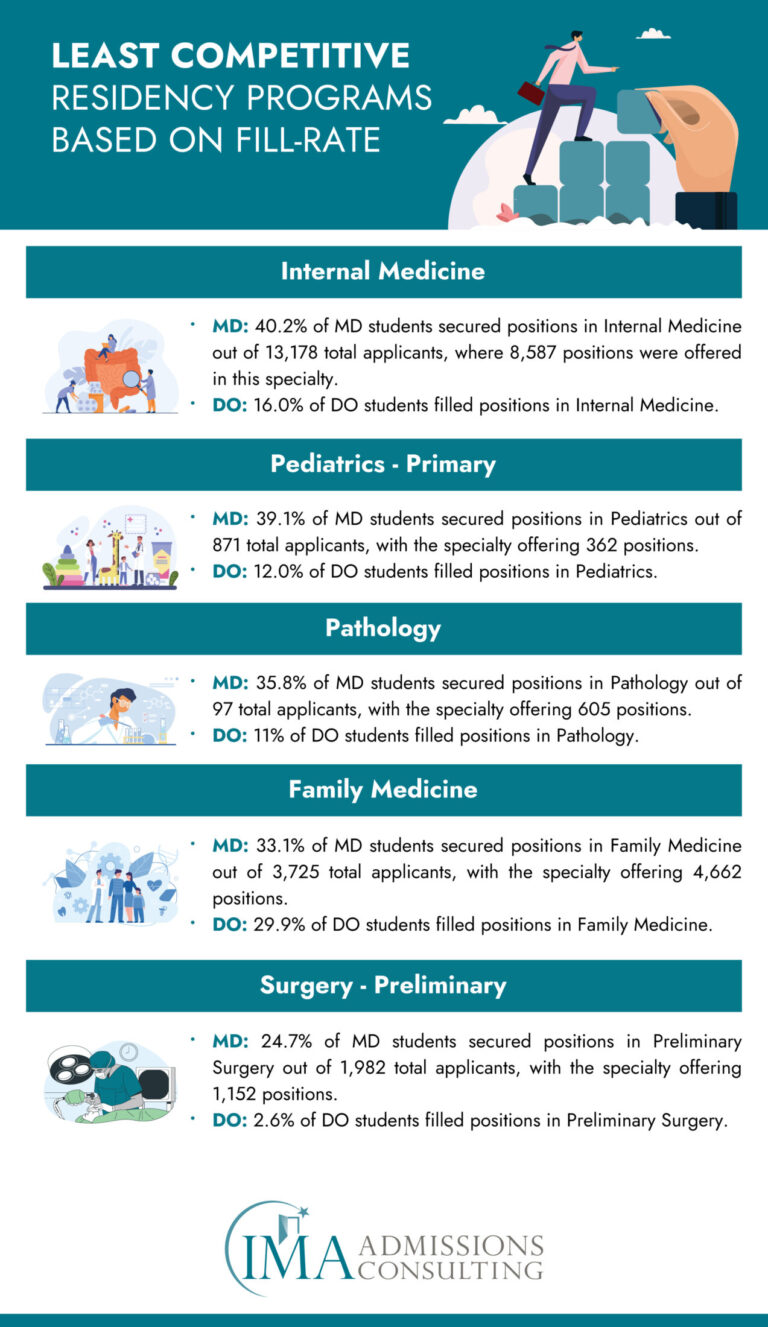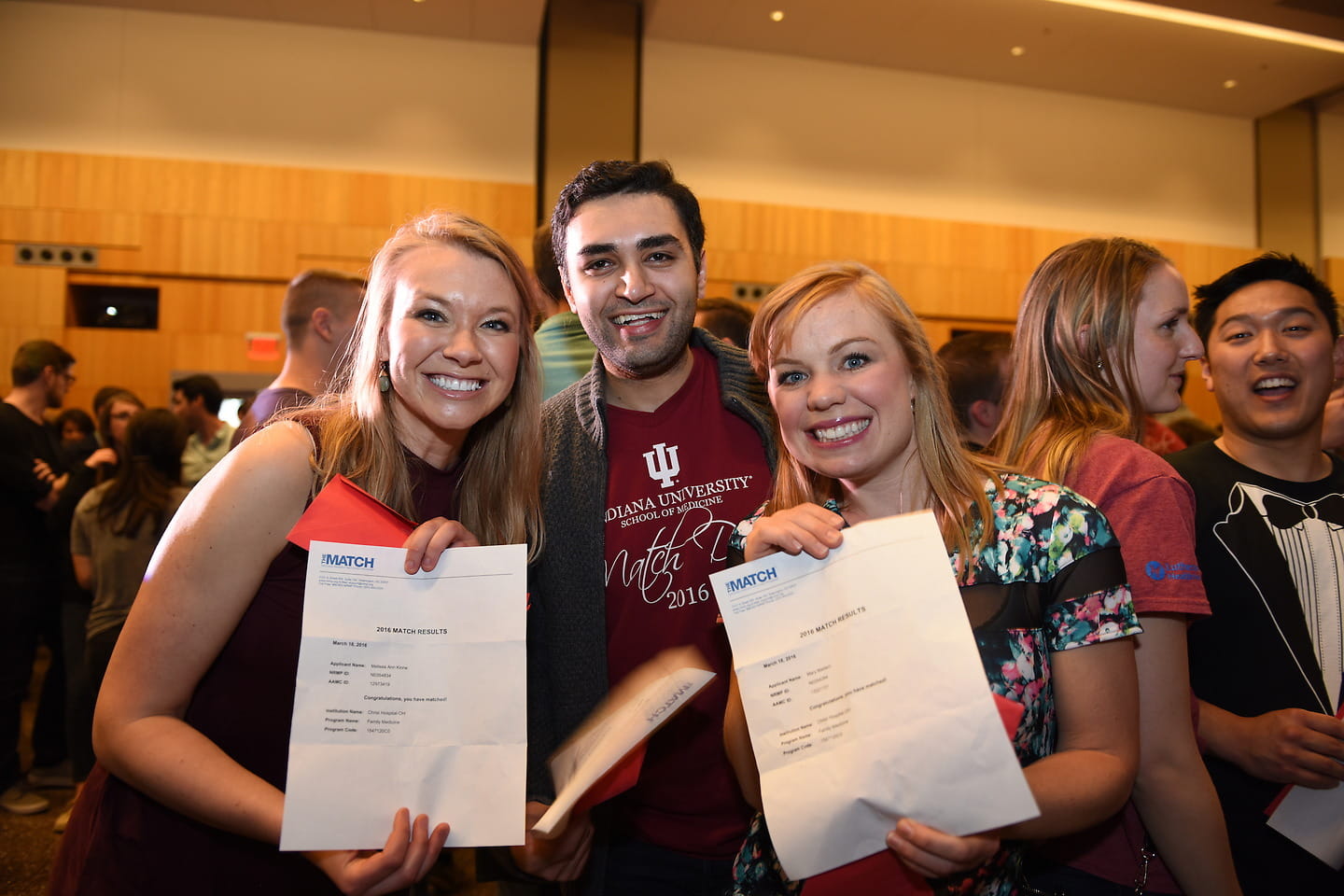The journey from being a medical student to becoming a practicing physician is marked by a pivotal event known as “Match Day.” It’s the culmination of years of hard work where graduates learn where they will spend their residency. The Residency Match Rate – the percentage of graduates who secure a residency position in their desired field – is a vital metric often used to evaluate the success of medical schools.
Let’s take a look into the intricacies of match rates, exploring why some medical schools consistently achieve high figures, the impact of DO versus MD pathways, and the factors influencing these outcomes. We’ll also explore the implications for medical students when selecting a school based on residency acceptance rates.
Residency Match Rates
Understanding the Residency Match Rate is essential for any medical student. It’s a figure that represents the proportion of graduates from a medical school who successfully secure a residency placement – a vital step in their medical careers. Residency Match Rates by Specialty further delineate which medical schools excel in placing students in various disciplines, revealing the schools’ strengths and focus areas.
MD (Doctor of Medicine) and DO (Doctor of Osteopathic Medicine) are two different types of medical degrees granted by medical schools in the United States, and their match rates into residency programs can differ based on several factors.
MD Match Rates
MD programs are allopathic medical schools that follow a traditional medical education model. Graduates of MD programs participate in the National Resident Matching Program (NRMP), also known as “The Match,” where they are placed into residency programs based on a mutual ranking system between applicants and residency programs.
MD match rates:
- Historical Data: Historically, MD graduates have had higher match rates compared to DO graduates, largely due to the prestige and recognition of MD programs, as well as a longer history and deeper integration within the residency selection system.
- Specialty Access: MD graduates often have a broader range of competitive specialties available to them, though this is rapidly changing as DO graduates continue to prove competitive in all specialty areas.
- International Recognition: MD degrees are universally recognized, which can sometimes make it easier for U.S. MD graduates to match into residency programs compared to DO graduates, particularly when considering international or highly competitive programs.
DO Match Rates
DO programs emphasize a holistic approach to medicine and incorporate osteopathic manipulative treatment (OMT) into their training. DO graduates historically had the option to match into either the NRMP or the AOA (American Osteopathic Association) Match, which was specific to osteopathic residency programs. However, as of July 2020, the AOA Match has been dissolved, and DO and MD graduates now participate in a single unified matching service through the NRMP after the transition to a single accreditation system for graduate medical education.
DO match rates:
- Improving Trends: With the single accreditation system, DO match rates have been improving and are becoming more comparable to MD match rates.
- Primary Care Focus: DO programs tend to emphasize primary care specialties, which generally have higher match rates due to a larger number of residency positions and less competition. This has contributed to strong match rates for DO graduates in fields such as family medicine, internal medicine, and pediatrics.
- Competitive Specialties: DO graduates have historically found it more challenging to match into some of the more competitive specialties, but this has been changing with the unified matching system, improved recognition of the DO degree, and the increasing number of DO graduates who excel in their medical training.
While both MD and DO graduates are fully qualified physicians, the difference in match rates has historically been influenced by the separate matching systems and the varying focus of the programs. With the integration of the matching systems and the increasing recognition of the quality of DO programs, the gap in match rates between MD and DO graduates is narrowing. Both MD and DO students must perform well academically, earn strong board scores, and secure solid letters of recommendation to maximize their chances of matching into their desired residency programs.
Medical Schools with the Highest Match Rates
Exploring Medical Schools with the Highest Match Rates offers insight into the caliber of education and training provided. These institutions often boast a supportive environment and extensive resources that prepare students for the competitive residency application process. However, this metric alone does not provide a complete picture of a medical school’s quality.
DO Schools with Best Match Rates also deserve recognition for their success in the matching process. These schools, which offer a Doctor of Osteopathy degree, emphasize a holistic approach to medicine, and many graduates enter primary care fields, which typically have higher match rates.
Several factors contribute to a medical school’s match rate. Competitive Specialty Preferences, such as the desire to enter high-demand fields like dermatology or surgery, can affect match outcomes. Additionally, Demographic Influence, including the location and language skills of applicants, plays a crucial role.

Top Medical Schools with Highest Match Rates
The match rate of a medical school is a percentage that reflects how many of its graduates secure residency positions through the National Resident Matching Program (NRMP). Here are some notable medical schools in the US with traditionally high match rates:
Harvard Medical School: Boasting a match rate of around 95%, with nearly half matching to Harvard-affiliated programs.
Weill Cornell Medical College: An impressive 99% match rate, with a significant majority securing positions in top-tier institutions.
Yale School of Medicine: Graduates enjoy a match rate where 94% land within their top five residency choices.
Stanford Medicine: Historically, Stanford has achieved a 100% match rate for its graduating class, though recent specific figures have not been disclosed.
University of Pennsylvania Perelman School of Medicine: Reports a match rate of about 98%.
DO Schools with Best Match Rates
Osteopathic (DO) schools focus on a holistic approach to medicine and often excel in primary care specialties. Some DO schools with remarkable match rates include:
DO Schools with Exceptional Match Rates:
University of North Texas Health Science Center College of Osteopathic Medicine: Nearly perfect match rates of 99% to 100% in recent years.
Campbell University School of Osteopathic Medicine: 99.85%
Oklahoma State University College of Osteopathic Medicine: 99.78%
West Virginia School of Osteopathic Medicine: 99.75%
Kansas City University of Medicine and Biosciences College of Osteopathic Medicine: 99.6%
Lake Erie College of Osteopathic Medicine: 99.6%
A.T. Still University of Health Sciences – School of Osteopathic Medicine in Arizona: 99.5%
Touro College of Osteopathic Medicine – Nevada: 99.5%
Edward Via College of Osteopathic Medicine: 99.38%
Lincoln Memorial University College of Osteopathic Medicine: A match rate of 94.1% for their most recent graduates.
This list highlights DO schools known for their superior match rates, underscoring their commitment to guiding students toward successful residency placements.
When considering medical schools, particularly DO institutions, it’s evident that certain high-performing schools, despite the generally lower match rates of DO compared to MD schools, achieve notable success in residency matches. The choice of specialty and school location can significantly sway a school’s match rates.
DO programs, often aligned with primary care, provide supportive pathways, resources, and connections beneficial for residency. To bolster match chances, clinical experience, strong COMLEX scores, active conference participation, and adept interview skills are pivotal. Each step, from gaining hands-on experience to excelling in standardized exams and interviews, plays a crucial role in enhancing a candidate’s profile for residency placement.
International Medical Aid offers guidance to maximize your match rate:
Understanding Match Rates: We can provide insights on how DO schools achieve high match rates, focusing on U.S. institutions.
Enhancing Clinical Experience: IMA advises on securing relevant clinical experiences, including our Internship Programs, crucial for a strong residency application.
Navigating COMLEX Scores: Our medical school admissions consulting provides guidance on preparing for COMLEX exams effectively, a significant factor in residency success.
Conference Participation: IMA helps identify key conferences, enhancing your professional network and knowledge base.
Interview Skills Mastery: We also offer comprehensive interview preparation, ensuring you present your best self to residency programs.
Factors Influencing Match Rates
Several factors can affect a medical school’s match rate:
Specialty Choice
Competitive Specialty Preferences: Graduates from prestigious institutions may vie for highly competitive specialties, which could potentially lower match rates due to the limited number of spots.
Primary Care Focus: Schools known for primary care may have higher match rates due to less competition in those specialties.
Residency-specific Placements
Focused Training: Schools offering specialized training or with strong hospital affiliations in particular fields can influence their graduates’ success in matching to those specialties.
Specialty-Specific Match Rates
Match rates can vary widely by specialty. While some specialties are more competitive with fewer residency spots available, others may offer more opportunities for graduates. Here’s a look at the residency match rates by specialty:
Most Competitive Specialties: Dermatology, plastic surgery, and orthopedic surgery often have lower match rates due to high competition.
Least Competitive Specialties: Family medicine, psychiatry, and pediatrics tend to have higher match rates due to a higher number of residency spots and lower competition.
For a more in-depth analysis, consider reading our article on the Most Competitive & Least Competitive Residencies.
Residency Match Rates by Specialty
| Specialty | Offered | #MD Filled | #Total Filled |
|---|---|---|---|
| Anesthesiology | 1609 | 1199 | 1606 |
| Child Neurology | 177 | 125 | 174 |
| Dermatology | 29 | 21 | 29 |
| Emergency Medicine | 3010 | 1274 | 2456 |
| Family Medicine | 5088 | 1484 | 4511 |
| Internal Medicine (Categorical) | 9725 | 3592 | 9345 |
| Medicine-Pediatrics | 392 | 307 | 388 |
| Neurology | 846 | 461 | 843 |
| Obstetrics-Gynecology | 1503 | 1102 | 1499 |
| Orthopedic Surgery | 899 | 690 | 899 |
| Pathology | 613 | 242 | 607 |
| Pediatrics (Categorical) | 2986 | 1635 | 2900 |
| Psychiatry | 2164 | 1343 | 2143 |
| Surgery (Categorical) | 1670 | 1062 | 1667 |
| Transitional (PGY-1 Only) | 1736 | 1015 | 1524 |
This table highlights the number of positions offered, the number filled by MD seniors, and the total number of positions filled for each specialty in 2023. For the full details and additional specialties or years, refer directly to the NRMP’s 2023 Main Match Results and Data Book.

Below is a structured table of data based on the provided document content, “2023-Main Residency Match® By the Numbers,” attributed to the National Resident Matching Program (NRMP):
Category Data Change from 2022
Total Positions 40,375 ↑ 1,170 (3.0%)
Total PGY-1 Positions 37,425 ↑ 1,148 (3.2%)
Total Positions Filled 37,690 ↑ 747 (2.0%)
Total PGY-1 Positions Filled 34,822 ↑ 747 (2.2%)
Unfilled Positions 2,685 ↑ 423 (18.7%)
Unfilled Positions Offered in SOAP 2,658 ↑ 396 (17.5%)
Percent of All Positions Filled 93.3% ↓ 0.9%
Percent of PGY-1 Positions Filled 93.0% ↓ 0.9%
U.S. MD Seniors Submitting Program Choices 19,748 ↓ 154 (0.8%)
U.S. MD Seniors Matched to PGY-1 Positions 18,498 ↑ 12 (0.1%)
Percent of U.S. MD Seniors Matched to PGY-1 Positions 93.7% ↑ 0.8%
Percent of PGY-1 Positions Filled by U.S. MD Seniors 49.4% ↓ 1.6%
U.S. DO Seniors Submitting Program Choices 7,436 ↑ 133 (1.8%)
U.S. DO Seniors Matched to PGY-1 Positions 6,812 ↑ 146 (2.2%)
Percent of U.S. DO Seniors Matched to PGY-1 Positions 91.6% ↑ 0.3%
Percent of PGY-1 Positions Filled by U.S. DO Seniors 18.2% ↓ 0.2%
Total Registered Applicants 48,156 ↑ 481 (1.0%)
Applicants Certifying Rank Order Lists 42,952 ↑ 403 (0.9%)
Applicants Matched to PGY-1 Positions 34,822 ↑ 747 (2.2%)
Percent of Active Applicants Matched to PGY-1 Positions 81.1% ↑ 1.0%
Couples Submitting Program Choices 1,239 ↑ 17
Couples Match Rate 93.0% ↓ 0.7%
Data Source: National Resident Matching Program (NRMP), “2023 Main Residency Match® By the Numbers,” retrieved from https://www.nrmp.org/match-data-analytics/residency-data-reports/.
Please note that the “Increases or declines reflect absolute percent changes since 2022” and that the numbers do not include the Match Week Supplemental Offer and Acceptance Program®. The “**Highest on record” signifies that the numbers for 2023 are the highest ever recorded up to that point.
Impact of the Single Accreditation System on DO Graduate Residency Match Rates
The transition to a single accreditation system for graduate medical education (GME) in the United States has had a significant impact on the match rates for DO (Doctor of Osteopathic Medicine) graduates. This transition was completed in June 2020 when the Accreditation Council for Graduate Medical Education (ACGME), the American Osteopathic Association (AOA), and the American Association of Colleges of Osteopathic Medicine (AACOM) reached an agreement to create a single GME accreditation system.
Here’s how the transition to a single accreditation system has affected DO match rates:

Increased Opportunities
Prior to the transition, DO students could participate in two separate match processes: the NRMP Match for both MD and DO graduates and the AOA Match exclusively for DO graduates. The AOA Match had a smaller number of residency positions, mostly in primary care and other specialties where osteopathic medicine is traditionally strong.
With the single accreditation system, all residency programs in the United States are now ACGME-accredited, meaning DO graduates can apply to a larger number of programs. This increase in options can lead to higher match rates for DO students, as they are no longer restricted by the number of AOA-accredited programs.
Improved Perception
The single accreditation system has also helped in standardizing the residency training for all physicians, which might contribute to an improved perception of DO physicians among residency program directors who were previously unfamiliar with the AOA accreditation standards. This can indirectly improve the match rates for DO graduates by removing any potential bias and leveling the playing field.
Specialty Access
DO graduates now have broader access to various specialties, including those that were previously less accessible, such as competitive surgical and subspecialty programs. This has enabled more DO graduates to match into their desired specialties, potentially improving overall match rates.
Challenges
However, the transition has also brought challenges. DO graduates are now directly competing with MD graduates for all residency spots, including those in highly competitive programs. This increased competition could affect match rates, particularly for DO students aiming for specialties where MD candidates have historically been preferred.
Data Trends
According to the National Resident Matching Program, the match rate for DO seniors has been increasing over the years. In 2021, the match rate for DO seniors was 89.1%, up from 84.6% in 2020. This trend suggests that the single accreditation system is positively affecting DO match rates.
Long-Term Effects
It is important to note that while initial data is promising, the long-term effects of the single accreditation system on DO match rates will become clearer over time as more data becomes available and as the system continues to evolve.
The transition to a single accreditation system has generally been positive for DO graduates, offering more opportunities and potentially improving match ratesThe transition to a single accreditation system for graduate medical education (GME) in the United States has had several implications for DO (Doctor of Osteopathic Medicine) graduates, particularly in the area of residency match rates.
Post-Transition to Single Accreditation System
The single accreditation system, overseen by the ACGME (Accreditation Council for Graduate Medical Education), has aimed to streamline GME in the United States. All residency and fellowship programs are now under the ACGME accreditation umbrella. Here are some effects of this transition on DO match rates:
Increased Competition: DO graduates now compete directly with MD graduates for all residency spots in the ACGME Match. This could potentially make it more challenging for DO graduates to secure positions in the most competitive specialties.
Greater Access to Programs: With the ACGME being the sole accrediting body for residency programs, DO graduates now have access to a larger pool of residency programs across all specialties, which could increase their overall match rate.
Enhanced Training Recognition: The single system standardizes the evaluation of educational standards for all residency programs, which may help to equalize the perception of DO and MD graduates in the eyes of program directors.
Elimination of the AOA Match: The AOA Match has been phased out, which means that osteopathic-focused residency programs previously accredited by the AOA had to obtain ACGME accreditation in order to continue training residents. This has helped to integrate osteopathic principles more widely into the broader GME framework.
DO-Friendly Programs: Programs that were previously AOA-accredited have transitioned to ACGME accreditation while still maintaining an osteopathic focus. This has allowed DO graduates to continue to pursue residency training that emphasizes osteopathic principles.
Impact on Match Rates
Since the full implementation of the single accreditation system:
- Early data suggested that DO match rates into ACGME-accredited residencies have been on the rise.
- The overall percentage of DO graduates matching to their preferred specialties has also been improving.
- There has been a noted increase in DO graduates matching into previously less accessible specialties, including some of the more competitive fields.
It’s important to note, however, that the match process is highly competitive for all graduates, and success depends on a variety of factors including USMLE/COMLEX scores, clinical experience, letters of recommendation, and research activities, among others. Therefore, while the single accreditation system has generally been seen as a positive development for DO graduates, individual outcomes can vary significantly.
For the most accurate and current information on match rates post-transition, it would be beneficial to refer to the latest NRMP and NRMP Match Reports, which provide detailed data on match outcomes across different medical education pathways.
Resources to Determine Residency Match Rate
When considering your future in the medical field and the path to residency, it’s crucial to have access to accurate and comprehensive data. Several resources provide invaluable insights into residency match rates, program rankings, and other essential metrics that can guide your decision-making process. Here are some reputable resources:
National Residency Matching Program (NRMP)
The NRMP is a central resource for residency applicants. It annually publishes the “Main Residency Match Data and Reports,” offering detailed statistics on applicant placements and match rates across specialties. You can access this wealth of information here. The reports offer a breakdown by specialty and present match rates for all participating medical schools, enabling a comprehensive analysis of trends and outcomes.
U.S. News & World Report
Renowned for its educational rankings, U.S. News & World Report provides an annual list of medical schools, taking into account various factors, including residency match rates. Their rankings can be a useful starting point for evaluating schools, though it’s important to consider the methodology and criteria used. Explore their medical school rankings here.
Association of American Medical Colleges (AAMC)
AAMC is a go-to source for aspiring medical students, offering a plethora of resources, statistics, and guidance on medical education, applications, and the journey to residency. Their website, AAMC, is a hub of information catering to various stages of a medical career.
Medical School Admission Requirements (MSAR)
MSAR is an online database that provides detailed profiles for each MD-granting medical school in the U.S. and Canada. It’s a valuable tool for researching schools’ admission requirements, student demographics, curriculum, and more. While the official URL was not provided, the MSAR can be accessed through the AAMC’s website or by searching for the Medical School Admission Requirements database.
Closing Thoughts
While residency match rates are a significant factor in evaluating medical schools, remember that they represent just one piece of the puzzle. Your choice should also be influenced by individual preferences, career objectives, and other key considerations such as location, cost, curriculum, and the overall culture and values of the institution. Use these resources as tools to inform your decision, but let your personal goals and circumstances guide your ultimate choice.
Ultimately, the match rate is just one of many factors to consider when evaluating medical schools. While a high match rate is certainly appealing, it is essential to assess the school’s overall quality, including its curriculum, faculty, research opportunities, and clinical training.
If you’re aiming for a top-choice residency, remember that individual qualifications, such as USMLE scores, letters of recommendation, and clinical experiences, are important. Selecting a medical school that aligns with your career aspirations and provides robust support throughout the residency application process is critical.
For personalized guidance on how to navigate the match process and maximize your chances of success, please schedule a call with our team, or feel free to chat with admissions using our helpful chat box.




